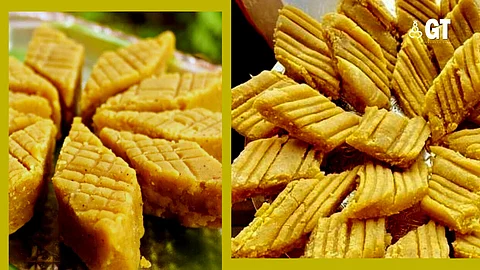

Doce de grão is a must at Christmas in the Goan kusvar. The rich flavour and sweet taste, the hint of cardamom, make it a favourite with young and old, alike.
The name, which originated from Portuguese, means ‘sweet grain,’ reflecting Goa's colonial past and its blending of Indian and Portuguese culinary traditions.
NOSTALGIA & MEMORY
As a child, I was introduced to doce de grão by my paternal grandmother. She would take pride in making all the tedious and traditional sweets as a young bride and mother, but gave it up with time, opting to be replaced by hired help to prepare the doce, and a few other sweets at home.
The image of seeing the lady stir continuously and vigorously while monitoring the woodfire's flame is a memory that lingers on in my mind.
LABOUR OF LOVE
The aroma of broken Bengal split-gram and fresh coconut coming together, and simmering meant something special was on its way in the kitchen.
Watching my grandmother monitor the goings-on and taking turns to stir the pot with care, I knew that this was more than just a treat — it was a labour of love.
SWEET TRADITION
The richness of the sweet keeps you coming back for more of this diamond-shaped sweet. Growing up, my love for doce de grão only deepened. It became more than just a childhood favourite; it was a connection to your roots, a way to remember and honour the traditions of family and celebrations.
Whenever friends and family from outside Goa or abroad visit home, doce is among the sweets offered or gifted. And, the same is the case when someone travels from Goa — doce is always packed in the baggage.
COMFORTING CONSTANT
Sharing doce de grão with friends and family, as an adult, brings a new kind of joy. It's a way to pass on the nostalgia, to introduce others to the flavours that shaped your childhood. Each bite is a reminder of where you come from and the simple pleasures that continue to bring happiness.
In a world that constantly changes, the taste of doce de grão remains a comforting constant, a sweet reminder that some things are timeless. And, I hope it remains so, especially when profit margins may be low due to competition, and commercialisation can mean compromising quality.
WEDDING VHOJEM
This sweet confection, made with Bengal gram (chana dal) and coconut, always forms an essential part of Christmas celebrations. It not only brings the family together but also adds to the joy and festivity.
Historically, this sweet has been an important part of Goan weddings, especially in South Goa, where the bride takes this sweet as part of her vhojem to the groom’s house, which is distributed to family and neighbours, as well as festive occasions.
FESTIVE SEASON
During Christmas, preparation of doce in the past was a community activity as members of the family and neighbours would gather together to share the labor-intensive process.
Making this sweet requires, both, patience and strength for it to achieve the perfect consistency.
WHERE TO FIND THE BEST DOCE IN GOA
Today, it's easier to purchase doce than to make it. My favourite places to buy fresh doce in Mapusa are Pascoal Bakery (Shop Number 333) near the flower market, and St Joseph Bakery.
In Candolim, La-Confiserie (near the football ground) is also known for good quality doce.
Confeitaria 31 de Janeiro (in Panjim) and The Goan Kitchen or Jackris Bakery (both in Margao) are a few more places to source quality doce de grão.
Antoinette Fernandes, from Pascoal Bakery in Mapusa, tells us that one batch of doce takes about three hours to prepare.
“It is a tedious process, and we generally make between 10 kg to 20 kg based on the demand. Christmas is the busiest time of the year for us,” she says.
APPROX PRICES
With the cost of coconut escalating during the festive season, among other things, the price of good quality doce de grão this year could range anywhere between Rs 560 to Rs 850 per kilo.
DOCE RECIPE
So, how about trying to make some doce at home?
YOU WILL NEED:
1 1/2 cups chana dal (Bengal gram)
4 1/2 cups sugar
6 cups grated coconut with white flesh only
1/2 tsp cardamom powder
1 tbsp ghee
A pinch of salt
PREPARATION:
Begin by soaking the chana dal in water for a couple of hours. Boil it along with a pinch of salt till soft.
Next, strain it; then grind it to a fine paste.
Grind the grated coconut to a fine paste, too.
Cook the mixture in a heavy-bottomed pan. Mix the chana dal paste, coconut paste, and sugar on medium flame, stirring continuously with a wooden spoon to prevent it from sticking to the bottom.
As the mixture thickens, it will start to bubble and splutter. Stir it constantly till it leaves the sides of the pan and accumulates in the centre. This is when you add the ghee and cardamom powder.
When done, remove it from the pan, and spread it on a greased surface. Smoothen it with a rolling pin when it's warm. Leave aside to cool.
Finally, cut into desired shapes and serve.
The tradition of making and sharing doce de grão during Christmas not only preserves the culinary heritage of Goa, but also strengthens bonds within the community.